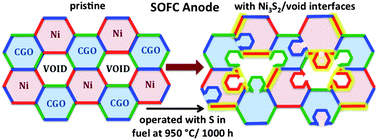Evolution of electrochemical interfaces in solid oxide fuel cells (SOFC): a Ni and Zr resonant anomalous ultra-small-angle X-ray scattering study with elemental and spatial resolution across the cell assembly
Abstract
Electrochemical interfaces are key to the direct conversion of fuels to electrical energy and lend energy converters like solid oxide fuel cells (SOFC) their functionality. Over extended operation at high temperatures, the microstructure of the underlying component materials in the cathodes, anodes and electrolytes evolve to an extent that these interfaces become affected and ultimately impaired, giving rise to performance degradation. We present anomalous ultra-small-angle X-ray scattering (anomalous USAXS) measurements to quantify the component phase interfacial surface areas as a function of position within the electrodes and electrolyte of a SOFC assembly. Using USAXS at a 3rd generation X-ray synchrotron facility, the primary microstructural parameters obtained are the mean feature size, size distribution and surface area, determined over a contiguous length scale from nanometers to micrometers in a single measurement at a given position. Here, a spatial resolution of <20 μm has been achieved perpendicular to the SOFC electrode and electrolyte layers. Anomalous USAXS measurements at X-ray energies just below the Ni and Zr K-absorption edges have enabled the electrochemically-active solid components and their associated void morphologies to be distinguished from each other close to the electrode/electrolyte interfaces. The anomalous variation of the X-ray scattering contrast with X-ray energy has been exploited to distinguish Ni-rich or Zr-rich component microstructures from adjacent phases, and to determine the interfacial surface areas both between specific solid phases and between each phase and the void network. Such information provides improved insights for relating the morphology of the SOFC triple phase boundary (TPB, where the reactant gas, electron-conducting and ion-conducting phases coincide) to the various component interfaces in the adjacent microstructure. We demonstrate how such measurements determine the electrochemically-active interface response to SOFC service life, especially in the anode with and without sulfur present in the fuel. Our approach can be generalized to address degradation issues at a quantitative level in other electrochemical systems such as batteries and photo-electrochemical cells.


 Please wait while we load your content...
Please wait while we load your content...